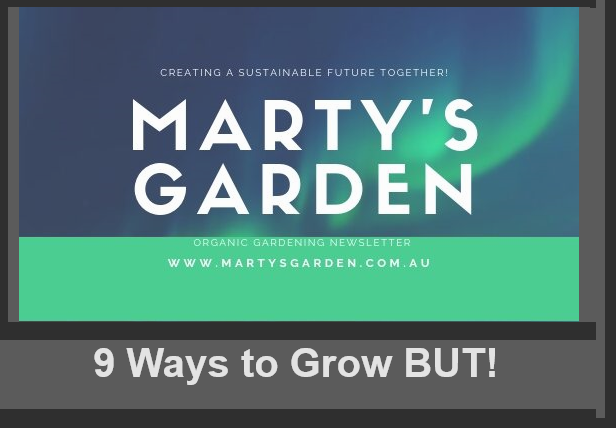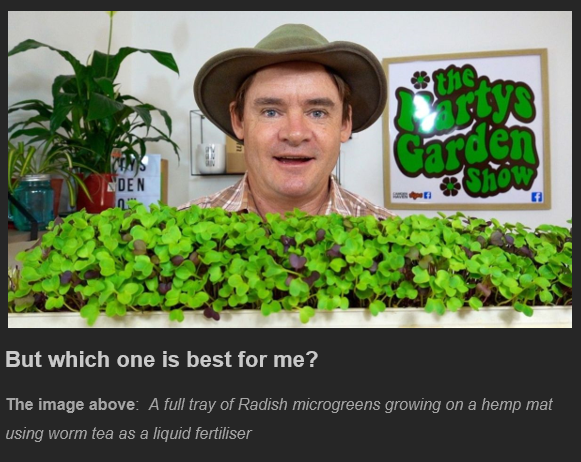

| But which one is best for me? The image above: A full tray of Radish microgreens growing on a hemp mat using worm tea as a liquid fertiliser Today I have an interesting article for you that I am sure many will enjoy because it will help you make a better-informed decision on which way you want to grow your fresh food at home. I have actually grown using all the methods mentioned below except one, aquaponics. You will definitely be using one of these growing methods or maybe a few. I will do my best in this short newsletter to help you make your choice. No matter what you choose remember it’s the end results we are after and that’s awesome fresh food on the kitchen table,, yummo! Microgreens – This method of food production starts at the top of the list as it’s awesome for the small space gardener, it’s highly nutritious, tasty and fast to grow. You can grow microgreens in compost, soil, hydroponics or use my prefered method compost and worm tea. Many crops you can harvest in just 7 days with the maximum being 14 days. If you can purchase seed cheaply it can be a very economical way to grow fresh food fast. You may even decide in the future to use seeds from certain plants to grow microgreens as a side crop. Container Gardening – Possibly the top choice for many in this community. Container gardening has a ton of benefits but can come with a couple of drawbacks such as drying out and requiring regular feeding. It’s true you can grow almost any plant in a pot these days and many are now growing large fruit trees in aero pots. The Aero pot self prunes the roots and grows amazing plants. I grow nearly all my herbs in containers and prefer to use the containers that have water well below. This way if I forget to water or go on holidays my plant still get a drink. With this crazy heat and dry weather lately, I have been moving my containers into a morning sun position only. Strawbales – This is a super fun way to grow fresh food at home and so many plants like to grow in this medium. It does take a lot of water to get them started though. However, once they trap the moisture they store it really well. Strawbale gardening is also a wonderful way to start a garden bed above the ground. Why? Because once it’s decomposed you just keep planting in it. All you have to do is keep layering compost on top. I have grown huge crops in bales over the years, everything from Lettuce, herbs, Tomatoes, Zucchinis, Chili’s, Cucumbers and too many more to mention. I did find that Cucumbers went crazy and performed the best out of everything I grew. Raised Beds – The most common way to grow food up high is in a raised bed and this method is a tried a true practice. If you are thinking about growing in raised beds make sure you grow in a quality bed mix that has lots of compost. You will also need to mulch really well and do your best to create a humus layer. I have had lots of success placing underground worm farms in raised beds. By placing an underground worm farm in your raised bed you increase fertilisation, moisture retention and help to build, restore microbe and fungal activity which is the basis to healthy soils. I have a full video tutorial in my worm farming course here on the subject if your interested. Wicking Beds – Wicking beds are a bit tricky to get started and in the very beginning take a while to settle in. Once they are established though and the water is soaking up and the roots have reached down they can be incredible. From my experience, not all plants like to grow in wicking beds. Herbs and leafy greens seem to do the best. As they create a very moist environment they are not always suitable for some plants that don’t like wet feet. If you live in a low humid environment then you may want to try growing Cucumbers, but keep an eye out for fungal issues in humid climates on certain plants. No Dig – The no-dig garden is great for those who have super hard soils, or soils that lack life. They do take a while to get started, but shallow-rooted plants like leafy greens and strawberries can be planted almost straight away. Be aware if you are using a lot of carbon in your bedding that in the beginning stages it will steal away vital nitrogen to help break it down. I recommend in the beginning stages to use lots of compost, worm castings and liquid fertiliser. As mentioned above I like to start mine off as a strawbale garden first. Hydroponics – A choice by many around the globe is hydroponics because it’s clean, relatively easy to use and provides all the nutrients with a plant requires. If you decide to grow in hydroponics you generally need a two-part mix. One part is for the leaf growth and the other for flowering and fruit set. Growing this way can be quite fun but from my experience a little more prone to pests and diseases. If you do take on growing using this method use only a high-end brand that has extra minerals for top results. Coco peat these days seems to be the bedding of choice for growing in hydroponics. Seek out a reputable brand as the cheap Coco peat generally isn’t so good. Aquaponics – I have never grown using aquaponics, but if you like the concept of growing organically in a closed-loop system then it just may be for you. It doesn’t use much water and it’s the fish waste that creates the nutrients. It can be quite expensive to start, but if your handy and like the concept of farming fish too, then you just may be on a winner here. Organic With Worms – My choice is what I believe to be simple, functional, sustainable and extremely healthy for myself and the planet. I grow all my plants in containers, in the ground and in compost this way. The plants in the garden beds are fed by the soil web. Basically, I feed the soil, not the plants and get very good results most of the time. On occasion, I will add some rock minerals, compost and mulch to gardens beds as a top-up. It’s super productive and a cheap way to grow as everything I require is made on site. When plants grow in nutrient-rich organic mediums generally there is fewer issues with pests and diseases as the plants build up their own immune systems to ward off the nasties. I only have a very small space, but able to grow all I require from herbs, leafy greens, fruits and microgreens using compost worms to help me. My container plants all grow in compost and worm castings with an occasional drink of worm tea. The worm tea sometimes comes straight from the worm farm or from a worm cast brew. There will be more coming up about worm tea in future newsletters, as it really is my secret to success! Learn how to make simple liquid fertilisers using worms in my latest course I grow lots of flowering herbs to attract pollinating insects, leave water out for the birds and have a small windbreak for them to hide and feel safe. The satisfaction of knowing I am providing a safe habitat for insects and the local birds is so satisfying. The birds also eat moths and caterpillars which is way cool. At the moment a couple of Magpies and a Willy Wagtail are doing a wonderful job. I hope this article has helped you make a choice and provided some cool tips for you. Maybe you want to try a couple of these methods? If you do I recommend that you don’t take on too many at the start. My advice, become really good at one and once you feel it’s been mastered maybe add another form of gardening to your repertoire. Please just remember to consider the environment and to help others achieve similar results, so we all move towards a fresh food future for all. Happy Gardening Marty Ware ps: Take your seed raising methods to the next level and give them the best possible start they can Course available here now and comes with private coaching |

You must be logged in to post a comment.